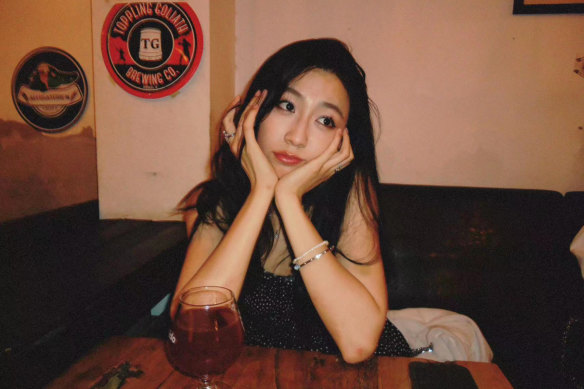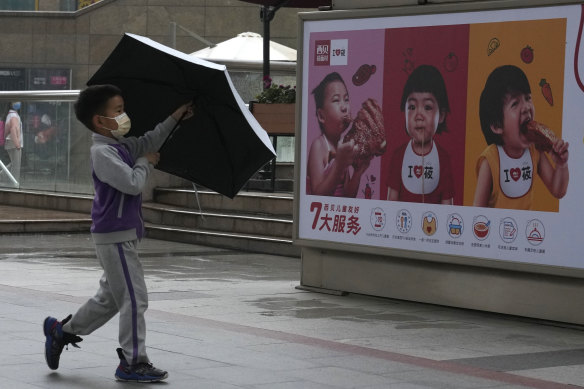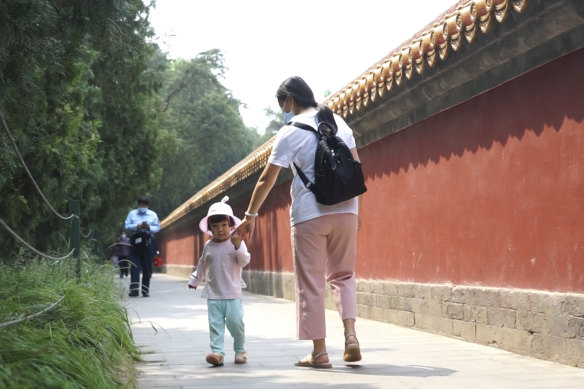By Lisa Visentin
Singapore: At 27 years old, Jiang Yi is certain she does not want to have children.
As an office worker in Beijing and a part-time model, Yi scrimps away her savings for one main purpose – to travel the world and experience new places, a lifestyle that cannot easily accommodate a child.
“Having a child will restrict my freedom of travel. Unless I find a very rich man, which is not likely to happen,” Yi says.

Jiang Yi, a 27-year-old office worker in Beijing, says she has no interest in having children.
But economic factors are also on her mind. Raising a child in China has become expensive, so much so that even the more affluent middle classes are baulking at the government’s exhortations and financial incentives for women to have more children.
“I earn roughly 10,000 yuan ($2112) plus a little extra income from modelling each month. I have a house, no car and some savings, but frankly speaking, it’s not enough to bring up a child,” Yi says.
“No, no matter how many government policies there are, they can’t help me give birth and bring up a baby.”

China’s ruling Communist Party has eased birth limits. But the babies are not showing up.Credit: AP
Yi is part of a generation of women born in the era of the Chinese Communist Party’s one-child policy who themselves are having few, if any, children.
China, like many of its neighbours, is now grappling with a demographic crisis of a shrinking and rapidly ageing population. Its population declined for the second straight year in 2023 to 1.409 billion people, falling by 2 million, according to the country’s National Bureau of Statistics.
Researchers from Victoria University in Melbourne and the Shanghai Academy of Social Sciences predict China will have just 525 million people by the end of the century.
What makes China different from Taiwan, Japan, Hong Kong and South Korea, which also have low and declining fertility rates, is that its crisis has been worsened by its own hand, supercharged by the one-child policy that remained in place for 35 years.
The policy, a massive social experiment that was strictly enforced by the government after it was rolled out in 1980, planted a demographic timebomb. It led to disputed estimates of millions of “missing women” due to sex-selection abortions and infanticide, and has left a huge gender imbalance: there are 30 million more men in the country than women.
Although it was officially abandoned almost a decade ago in 2016 and replaced with the two-child policy and then the three-child policy in 2021, its impact continues to have far-reaching consequences for the Chinese economy.
Demography experts say the policy’s legacy is playing a key role in shrinking the country’s labour force, with fewer births meaning there are fewer younger workers to drive innovation and growth, while a greater chunk of welfare, resources and investment is spent on the burgeoning elderly population.

Mother-of-two Yue Yan looks after one of her daughters at a park in Beijing. Yue, 35, spends her days looking after her two-year-old and evenings helping her 10-year-old with homework. Credit: AP
Dr Fuxian Yi, a demographer and an obstetrician at University of Wisconsin-Madison, has been a prominent and vocal critic of the one-child policy, drawing the ire of Chinese authorities for being among the early crusaders to sound the alarm about its economic consequences.
“China’s population crisis is very severe. The one-child policy changed people’s idea of family and also changed the economy,” Yi said, adding the idea of having only one child became entrenched.
Yi maintains he was blacklisted from returning to China after telling The New York Times in a 2016 interview that China’s economy would “never overtake America’s, because of the decrease in the labour force and the ageing of the population”.
Chinese authorities have since spent billions on measures aimed at boosting the fertility rate, such as improving maternity leave and childcare access, as well as tax deductions and housing subsidies for families. President Xi Jinping last year called on women to “create a new trend of family”, one based in a “new culture of marriage and childbearing”.

A young couple take wedding photos on top of a mountain in south-west China’s Sichuan Province. But changing attitudes are making women turn away or delay marriage and childbirth.Credit: Sanghee Liu
But these measures and new three-child baseline have so far failed to deliver a baby boom. The fertility rate now hovers around 1, well below the 2.1 rate needed to maintain a stable population. By comparison, Australia’s fertility is around 1.6.
He Yu, a 28-year-old software programmer at an aerospace company in Beijing, says getting married and having a baby has become a distant prospect in the face of gruelling work expectations.
“I work like a mule,” she says.
Punishing work schedules known as the “996” – 9am to 9pm, 6 days a week – remain a major source of grievance among younger workers, even though they were banned by authorities in 2021.
“Under my current financial situation, I can’t afford to have a baby now. I will only consider it when I have enough money,” Yu says.
Dr Xiujian Peng, at Victoria University, says another consequence of the one-child policy has been to raise the educational attainment of girls, who did not have to compete with brothers for access to schooling, which changed women’s expectation around career goals. When combined with the present day’s highly competitive labour market, and inflexible workplaces for mothers, this has also dampened the fertility rate, as women delay getting married and having children to later in life.
“Women are saying they don’t have the time and energy to think about having a baby. The government really needs to think about shortening working hours and also giving women a more flexible working environment,” she says.
The old policy also turbocharged a culture of intensive parenting, with families pouring money and time into their only child to ensure they succeeded and had the resources to take care of them in old age. This, in turn, sent education expenses skyrocketing, as parents competed to secure for their child access to the best tutoring, colleges and extracurricular activities.
“When they think about potentially becoming a parent, especially now that education is costly, and requires lots of parental involvement, it’s not just whether they want to have children, it’s also about whether they can afford to,” says Dr Zheng Mu, a sociologist at the National University of Singapore.
These factors loom large in the mind of Jin Lilan, a mum to a four-year-old boy. At 36, she yearns for another child. But with her husband currently unemployed, and being the sole breadwinner (she works at an automotive part company in Beijing), the cost of raising one child is already challenging.
“We no longer buy high-end snacks and clothes for him. In the future, apart from kindergarten tuition, extracurricular classes such as dancing or piano will be another big expenditure,” she says.
“Old Chinese people often say, ‘having one more member of the family is just putting one more pair of chopsticks on the dining table’. But today’s parents at my age have a different view. We care more about quality of life and value education.”
Get a note directly from our foreign correspondents on what’s making headlines around the world. Sign up for our weekly What in the World newsletter.